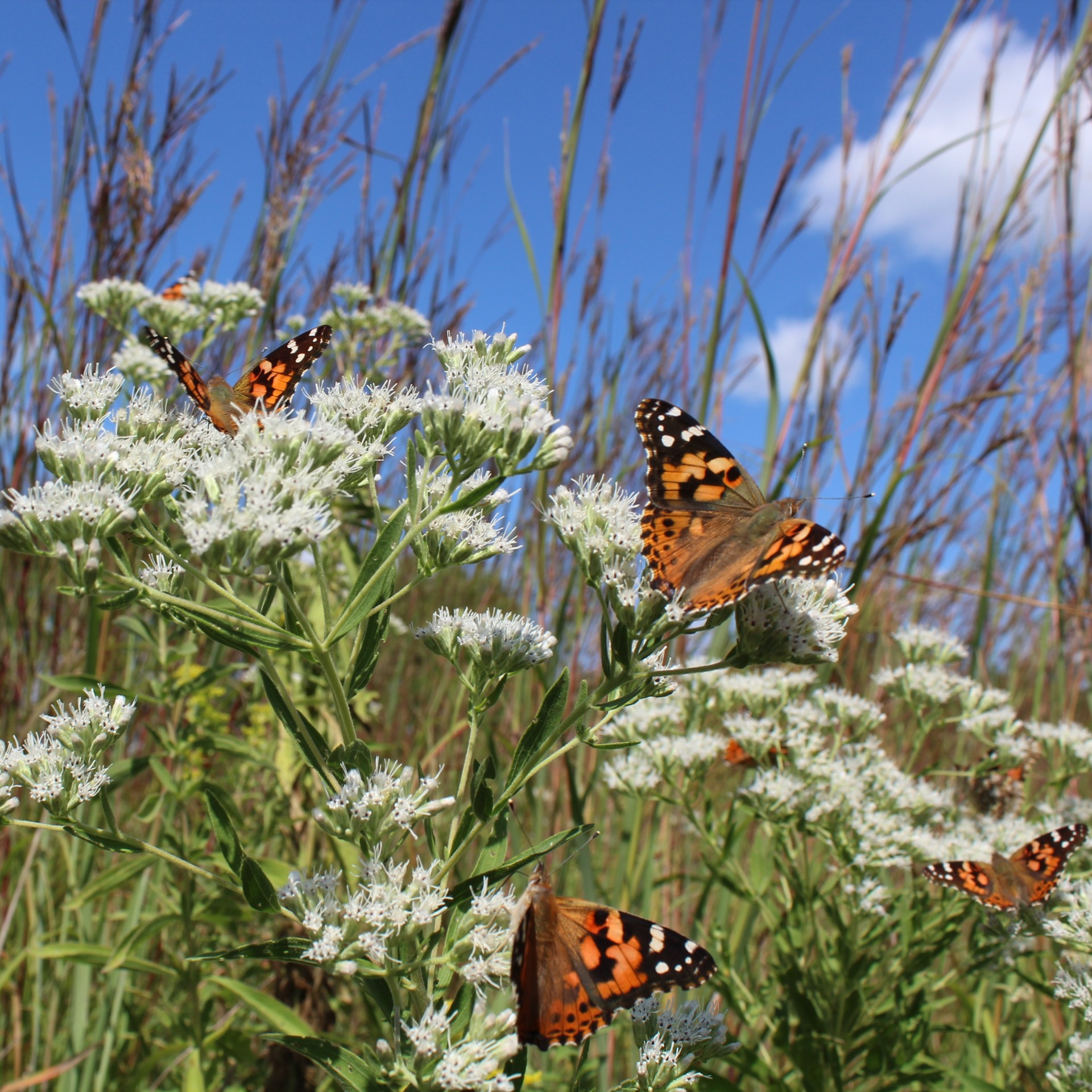Insect Retirement? Really?
Just as spring abounds with new life, fall seems to be neck-and-neck in the rush of creature retirement. Like it or not, insects and spiders are the most abundant creatures on earth. In Iowa, hundreds of different species of insects, including important pollinators, have ventured from egg to adult, worked all summer to help us prepare food resources and are now preparing for spring regrowth (laying eggs), retirement, and death.
Some insects go through a period of time that improves their chances of survival. They cannot eat, reproduce, or move around. Their physical functions are slowed down as if they are in a deep sleep. We refer to this as dormancy. Overwintering insects may be hiding in leaf litter, under the bark of a tree, or deep into the soil. Many insects perish before winter arrives and rely on eggs laid in protected areas to begin new life in the spring.
As temperatures drop, male bumblebees and worker bees will perish. The queen is the only one to prepare for hibernation in a hole in the soil, in leaf litter, or rotting stumps, and logs. She can stay in hibernation for six months or more. In late spring, she emerges, builds a nest, and creates a new team of bees.
Another fascinating insect that creates one of the most elaborate nests is the bald-faced hornet. When leaves drop, the nests they build become visible to us within tree limbs along woodland edges.
These unique nests are only used for one season. Animals and birds tear them apart when they become visible and eat any larvae or hornets that remain. By the end of the summer, males and new queens produced in late summer leave the nest to mate. All the queens will go into a dormant state filled with eggs, as the old queen and males will perish. As the new queens emerge in late spring, they choose a place that will be sheltered from weather, lay many eggs (all sterile daughters) and those young of the year create the more sizable nest and gather food while the queen rests and lays more eggs.
A few butterflies also survive through dormancy in an adult stage i.e., the mourning cloak, red admiral, and the painted lady. There may be sightings of these butterflies flying during the winter on a warm day. Some species will lay eggs on twigs and leaves and await the coming of spring. Hibernating caterpillars survive by burrowing in the leaf litter at the base of their host plants as the fall approaches.
Many of us get involved throughout the spring and summer to help monarch butterflies by planting many species of milkweed. We know that they migrate and spend their winters in the highlands of Michoacan in Central Mexico. According to Iowa State University Extension entomologists, the monarch must be reintroduced into the state every spring by north-bound dispersal of last year’s butterflies and their offspring. Have you ever seen a tagged monarch or a large group of monarch butterflies huddling tree branches and feeding on the flowers of prairies and grasslands? Check out the Monarch Watch program (https://www.monarchwatch.org/) to learn more about monitoring monarch populations. Almost every county in Iowa offers a fall monarch tagging program that you can attend. You can be involved with learning about monarchs and monitoring monarch populations.
Visit Plant.Grow.Fly to learn what can be done locally! https://www.blankparkzoo.com/conservation/plantgrowfly
The real-life dragons and damsels are another magnificent insect. Fossils and historical information studies have noted that they lived here long before the dinosaurs roamed over 250 million years ago. After breeding, the female dragonfly lays her eggs along the water’s edge. Once the eggs hatch, their first stage of life begins. We call this stage larvae or ‘nymph.’ They are predators to other insect larvae, tadpoles, and small fish. They will overwinter as nymphs under the ice within the plants and mud. Some dragonfly nymphs stay at this stage for one to three years before they undergo metamorphosis into an adult dragonfly. Dragonflies and damsels spend more time as aquatic larvae than they do in the air. As adults they are agile fliers, are predators to many flying insects, but they too become prey to birds, frogs and fish, and even other dragonflies. There are migratory dragonflies, and it is an amazing sight to see hundreds moving through. One example of a migratory dragonfly is the common green darner.
Just about any garden will be home to several types of spiders. The most common spiders do not spin webs – some live in the ground and will feast on slugs, others use a single strand of silk between vegetation, and some look like crabs running along a beach with oversized front legs waiting patiently for a particular insect landing on a flower. Spiders are eight-legged and are arachnids, not insects. These groups of spiders are extremely beneficial predators. The familiar yellow and black garden spiders are common and considered the great ‘Guardians of the Garden.’ These colorful spiders weave a lovely circular web, so we give them the name of orb-weavers. Some call these spiders ‘writing’ spiders because of the visible zigzagging pattern within the web. National Wildlife Federation experts believe the function of the zigzagging x-pattern may assist in alerting birds to the presence of the web, so they do not destroy it or fly through it. These colorful orb weavers create a new web each day, changing the angles and assuring it is strong and not messy.
Attention educators and children! Do you like geometry? That might be a scary question for some of us, but there are some really fun activities that can apply principles of geometry, architectural designs, and engineering all by learning and observing our backyard wildlife. Check out these links and learn from the orb weavers! Make your own observations and activities involving wind direction, temperature, angles, heights, direction of a spider’s abdomen and surface area covered. Please note that spiders and their webs should only be observed, not damaged and or harmed.
Learn more about spiders here: Project WILD Activity Guide – Project WILD is an interdisciplinary, supplementary environment and conservation education program for educators of kindergarten through high school young people.
-
- Spider Web Geometry: Math, Science, Language Arts, Art
- Interview A Spider: Discussion reading research, creative writing, interview
-
- Wild Kratts – Secrets of the Spiders Web (https://www.youtube.com/watch?v=KX2HzjI0XO4) – Storyline: Two miniaturized Kratts explore the world of the spider and how it creates its web, finding clues along the way that indicate what spider silk is made of that will help Aviva to replicate it.
-
- Keepers of the Animals, Native American Stories and Wildlife Activities for Children by Michael J. Caduto and Joseph Bruchac, Sticky Web activity, page 37 and other fun activities about webs and spiders. Great Books!
-
- Growing up wild - Spider Web Wonders – (https://www.fishwildlife.org/projectwild/growing-wild/resources/spider-web-wonders) Growing up Wild PreK-2nd Grade
-
- Iowa Public Radio Talk of Iowa with Charity Nebbe and Iowa State University Extension Entomologist Donald Lewis – Why certain insects are coming indoors this time of year. (https://www.iowapublicradio.org/podcast/talk-of-iowa/2021-11-06/heres-why-certain-insects-are-coming-indoors-this-time-of-year)
Insect life can be short or long, but again, we need them to assist us with food production and diversity within our ecosystems. What can you find on your fall hikes and travels?
published Wednesday, September 21, 2022



